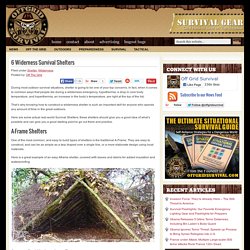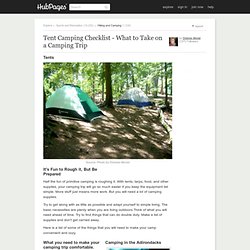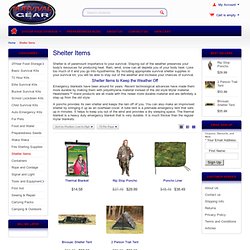

Camping Life Magazine. August 1, 2003 Filed under Feature Stories Whether you camp in an improved campground with all the amenities or on a patch of open ground in the backcountry wilderness, there are ways to make your outdoor living experience easier, safer and more ecologically responsible.

Make good use of those tips that lend themselves to your style of camping. 1 Arrive early. Give yourself plenty of time to set up camp before dark. 6 Widerness Survival Shelters. During most outdoor survival situations, shelter is going to be one of your top concerns.

In fact, when it comes to common ways that people die during a wilderness emergency, hypothermia, a drop in core body temperature, and hyperthermia, an increase in the body’s temperature, are right at the top of the list. That’s why knowing how to construct a wilderness shelter is such an important skill for anyone who spends any amount of time in the great outdoors. Here are some actual real-world Survival Shelters; these shelters should give you a good idea of what’s possible and can give you a good starting point to go out there and practice. A-Frame Shelters One of the most common, and easy to build types of shelters is the traditional A-Frame.
Gallery : Wilderness Survival Skills. How to Forecast Weather. Ever wondered how to forecast the weather without actually using instruments? Check the Clouds: Clouds can tell us a lot about the weather. For example, they can tell us if it’s going to be warmer on a particular night by simply being there. That’s because they prevent heat radiation from escaping.
They can also tell you whether there will be rain and whether there will be bad weather in general (when you see clouds moving in opposite directions of each other). Check the Humidity: If you’re one of those people whose hair gets all curly when it gets really humid out, you know exactly what this is about. Check the Animals: Birds only fly in the sky when they expect fair weather ahead. Look at the Rainbow (but only in the west) and look for a Red Sky: If you see one in the west, it means a major storm front is coming. Check the Air: If it smells like a compost heap, expect some rain soon.
Check the Moon: Seen any red moons lately? Check the Wind: How To Build A Shelter In A Forest (Wilderness Survival) Natural shelter in the wild is a potential life saver.

If you do not have a tent or bivouac with you, knowing how to make a lean-to shelter is one of the most important bush craft survival skills. So watch VideoJug's guide to building a shelter in a forest. Step 1: You will need An uprooted tree Some sturdy branches Plenty of leaves and debris from the forest floor Step 2: Preparation Make sure you choose the right spot to make camp. Step 3: Location You will need to find the right structure to lean your branches against, an uprooted tree is perfect, especially if it has a hollow where the roots once were as this will give you more space inside. Step 4: Construction Now you have the main structure you will need the branches to create the rest of your shelter. The shelter can be made from fallen branches and debris. How to Make a Shelter in the Wilderness.
How To Build A Log Cabin. Yurt Buildng. Here is a free copy of my book Build your own yurt, written in 1995, It has been used by a great many people who have built their own yurts.

Our designs have progressed enormously since 1995. For a much more comprehensive guide see The Complete Yurt Handbook or see the rest of our website A complete guide to making a Mongolian Ger by P.R. King First edition 1995, Second edition 1997. Third edition, revised, updated, and expanded. 1997. Third Edition Fully revised and expanded for 1998 Internet Edition Jan 2000 The Yurt The English word Yurt comes from the Russian Yurta describing a circular trellis walled framed tent.
The Kirgiz yurt with bent-wood roof poles and crown and a domed overall shape. The two tiered yurt with a pointed roof and two layers of wall section placed one on top of the other. The Mongol or Kalmuk ger with straight roof poles, a heavy timber crown, often supported by two upright poles, and fitted with a wooden door. Figure 1. Primitive Camping – Dos and Don’ts.
The term “primitive camping” may be a bit deceptive.

It implies camping in an uncivilized wilderness, killing your food with your hands and reverting to cave man life, or what we think of as caveman life. But primitive camping, while much more of an adventure than camping in prepared camp grounds doesn’t have to be dangerous or harsh. Just like anything else, with good training and preparation, it can be great fun and an exciting adventure for your team. Welcome to Primitive Camping.org! Primitive Camping Supply List Essentials. Primitive Camping Information for Campground Locator & Source of Camping Information- A camping search engine for outdoor enthusiast to find State, National, & privately owned parks and fulfill all of your camping needs. Tent Camping Checklist - What to Take on a Camping Trip. While RV camping may seem comfy and convenient, tent camping is for those hearty souls who want to dance in tune with nature.

Tent camping requires you to pare down on equipment, food, clothing and the extraneous junk of modern life. Here is a list of essentials to make your tent camping experience comfortable and rewarding. General Equipment Tent (with screens and windows), poles, stakes and a mat for outside the door Sleeping bags, air mattress and pump or camp pads Lantern, fuel and extra mantels Flashlights and extra batteries Ground cover and tarps Rope, cord, twine, or clothesline Multi-purpose tool or knife Ax – if you are allowed to cut wood for fires First aid kit Old towels and rags Insect repellant (dryer sheets work well) Rain gear (poncho) Toilet paper Biodegradable soap Small folding shovel Clothing that can be layered Sunblock Kitchen Extra Stuff Be creative.
Bug Out Bag Shelter 1. Bug Out Bag Shelter 2. How to set up a Hammock - A Guide to Hammocking. Shelter Supplies. Shelter is of paramount importance to your survival.

Staying out of the weather preserves your body's resources for producing heat. Rain, wind, snow can all deplete you of your body heat. Shelter.